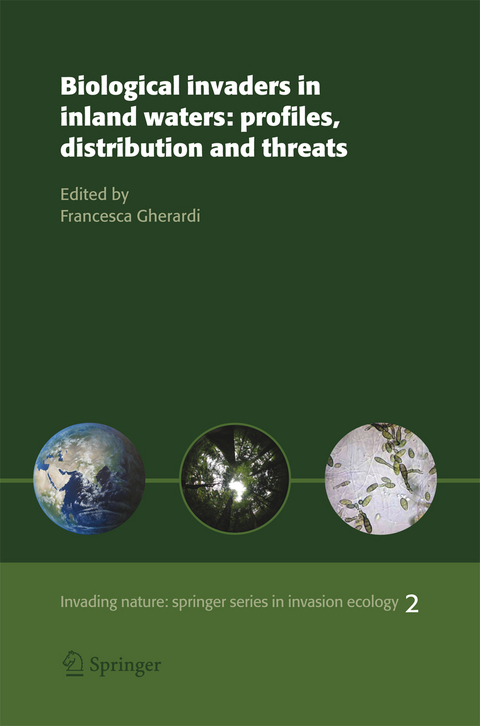
Biological invaders in inland waters: Profiles, distribution, and threats
Springer (Verlag)
978-90-481-7509-3 (ISBN)
The book examines the identity, distribution, and impact of freshwater non-indigenous species and the dynamics of their invasion. Rather than providing a broad and comprehensive review of the issue, Biological invaders in inland waters focuses on old and new invaders and also raises questions and opens perspectives that provide a starting point for further research. The ultimate purpose of this book is to help define a more general framework for our knowledge of invasions in fresh waters. Such a framework will be indispensable to the planning of a science-based management program.
Biological invasions in inland waters: an overview.- Distribution of invaders.- Invasive crustaceans in European inland waters.- Non-indigenous freshwater crabs in France: a new occurrence of a potamid near Nice.- Status and ecosystem interactions of the invasive Louisianan red swamp crayfish Procambarus clarkii in East Africa.- Non-indigenous freshwater molluscs and their distribution in Italy.- Non-indigenous animal species naturalized in Iberian inland waters.- An overview of the natural history of non-indigenous amphibians and reptiles.- The red-eared slider (Trachemys scripta elegans) in Asia: a review.- Semiaquatic mammals introduced into Italy: case studies in biological invasion.- Invasions by plants in the inland waters and wetlands of Africa.- Non-indigenous aquatic and semiaquatic plant species in France.- Profiles of invaders.- Ecological traits of aquatic NIS invading Austrian fresh waters.- Growth and reproduction of the goldfish Carassius auratus: a case study from Italy.- Epigenetic context in the life history traits of the round goby, Neogobius melanostomus.- Growth and life history traits of introduced pumpkinseed (Lepomis gibbosus) in Europe, and the relevance to its potential invasiveness.- The biological flexibility of the pumpkinseed: a successful colonizer throughout Europe.- Patterns and pathways of invasions.- Marine vs. freshwater invaders: is shipping the key vector for species introductions to Europe?.- Modeling biological invasions of inland waters.- Biomonotony: definition and assessment for macroinvertebrates in European running waters.- Genetics and invasion biology in fresh waters: a pilot study of Procambarus clarkii in Europe.- Do estuaries act as saline bridges to allow invasion of new freshwater systems by non-indigenous fish species?.- Which factors determine non-indigenous fish dispersal? A study of the red piranha in tropical Brazilian lakes.- The relationship between biodiversity and invasibility in central Swedish lakes invaded by Elodea species.- Impacts of invaders.- Measuring the impact of freshwater NIS: what are we missing?.- Invasion of the Baltic Sea basin by the Ponto-Caspian amphipod Pontogammarus robustoides and its ecological impact.- Changes in the aquatic systems of north-eastern Europe after invasion by Gmelinoides fasciatus.- The predatory impact of Dikerogammarus villosus on fish.- Understanding the impact of invasive crayfish.- Predation of invasive crayfish on aquatic vertebrates: the effect of Procambarus clarkii on fish assemblages in Mediterranean temporary streams.- Assessing the trophic ecology of crayfish: a case study of the invasive Procambarus clarkii.- and spread of crayfish (Parastacidae) in Western Australia and their potential to displace indigenous species.- The zebra mussel Dreissena polymorpha: reproduction and competition with the sponge Ephydatia fluvia.- Seasonal effects on the antioxidant response and metal accumulation of Dreissena polymorpha.- Managing invasions.- Towards a European strategy to halt biological invasions in inland waters.- A risk assessment of biological invasions in the inland waterways of Europe: the Northern Invasion Corridor case study.- Logistics of shipboard and dockside testing of ballast water treatment systems in the United States.- Virtues and shortcomings of EU legal provisions for managing NIS: Rana catesbeiana and Trachemys scripta elegans as case studies.- Problems and opportunities managing invasive Bullfrogs: is there any hope?.- Concluding remarks.- A role for scientists.
| Erscheint lt. Verlag | 18.11.2010 |
|---|---|
| Reihe/Serie | Invading Nature - Springer Series in Invasion Ecology ; 2 |
| Zusatzinfo | XXX, 734 p. |
| Verlagsort | Dordrecht |
| Sprache | englisch |
| Maße | 160 x 240 mm |
| Themenwelt | Naturwissenschaften ► Biologie ► Ökologie / Naturschutz |
| ISBN-10 | 90-481-7509-7 / 9048175097 |
| ISBN-13 | 978-90-481-7509-3 / 9789048175093 |
| Zustand | Neuware |
| Haben Sie eine Frage zum Produkt? |
aus dem Bereich


